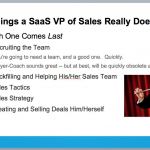- Like
- SHARE
- Digg
- Del
- Tumblr
- VKontakte
- Flattr
- Buffer
- Love This
- Save
- Odnoklassniki
- Meneame
- Blogger
- Amazon
- Yahoo Mail
- Gmail
- AOL
- Newsvine
- HackerNews
- Evernote
- MySpace
- Mail.ru
- Viadeo
- Line
- Comments
- Yummly
- SMS
- Viber
- Telegram
- JOIN
- Skype
- Facebook Messenger
- Kakao
- LiveJournal
- Yammer
- Edgar
- Fintel
- Mix
- Instapaper
- Copy Link
In customer success, your customers define their own victories. No one-size-fits-all finish line exists that clients must strive to cross, and there is no Harvard Business School concept of accomplishment you can award your customer before resting on well-earned laurels.
That’s because defining customer success is a long-term joint project undertaken by you and your client. Customer success means creating data-driven engagements that provide ongoing value to the customer and growth opportunities to the enterprise.
The key word is “ongoing.”
In an ongoing pursuit of value, the ideas of “finish lines” and “completion” are replaced by “milestones” and “progress.” Ultimately, you and your customer must create your own customer success definition that is measurable, flexible, and equates directly to real-world growth.
Creating Better Customers, by Definition
The goal of this ongoing delivery of value is to create better customers. Every customer you currently service has potential for value that outweighs, perhaps by a great deal, their current status. But realizing that value requires that you first help your customer achieve value.
Your customer is a long-term partner; the two of you are on a journey together. Ideally, this long-term partnership will see your customer reach milestones with your help, expand their use of your product, and upsell or cross-sell in other ways. In other words, you will need to ask yourself if your customer is achieving the incremental targets that mean that both of you will be better off tomorrow than you were yesterday.
Reconsidering Your Customer Success Definition
The digitization of business has placed the customer firmly in control of their service arrangements, and, in turn, has changed the way enterprises derive value from and serve their customers. Customers are empowered to enter recurring short-term business solutions with personalized services.
They derive value from your product by having it mold to fit their daily workflows and drive achievement of measurable milestones. In response, your enterprise must align your goals with that of the customer in order to maximize customer lifetime value (CLV) for both parties. For your company, customer success translates into the proactive creation, maintenance, and growth of CLV. For the customer, success is defined by the achievement of their unique business goals over time.
Defining Customer Success Throughout the Customer Journey
The customer success approach breaks down the customer journey into simple, easy-to-manage stages. Each stage can then be assigned goal-driven actions that guide customer engagements and keep them on track to long-term growth. KPIs can help you see how you and the customer are performing against your stated goals.
These stages are seldom linear in their progression, but customers generally experience the following stages:
 Onboarding: In this critical phase of first impressions, the goal is to accelerate the experience of value by helping the customer rapidly integrate your product into their daily workflows. Goals might be to consistently meet implementation timelines and deliver a great customer experience.
Onboarding: In this critical phase of first impressions, the goal is to accelerate the experience of value by helping the customer rapidly integrate your product into their daily workflows. Goals might be to consistently meet implementation timelines and deliver a great customer experience.
- Customer definition of success: Learning to use your product is smooth and easy and the customer progresses quickly through the stages of onboarding. The customer begins to confidently and independently put your product to practical use and reaches first value quickly.
 Adoption: This is the longest phase of the customer journey, in which the customer starts using your product to generate value. Your goal is to maximize license utilization and usage frequency and ensure the right customer is using high-value features.
Adoption: This is the longest phase of the customer journey, in which the customer starts using your product to generate value. Your goal is to maximize license utilization and usage frequency and ensure the right customer is using high-value features.
- Customer definition of success: The customer uses your product effectively and regularly in a way that helps them reach goals that you have set together.
 Advocacy: Customers in the advocacy stage are willing to share success stories with other customers or potential prospects. Turning customers into advocates is a great way to spread the word about your product. You can make customers into advocates by identifying customer goals and acknowledging when they are met, going above and beyond in your response/handling of customer escalations, making onboarding a quick and smooth path to value, customize communications and offerings, offering extra value such as webinars and beta or early access to features, and by using NPS scores to determine customer satisfaction level.
Advocacy: Customers in the advocacy stage are willing to share success stories with other customers or potential prospects. Turning customers into advocates is a great way to spread the word about your product. You can make customers into advocates by identifying customer goals and acknowledging when they are met, going above and beyond in your response/handling of customer escalations, making onboarding a quick and smooth path to value, customize communications and offerings, offering extra value such as webinars and beta or early access to features, and by using NPS scores to determine customer satisfaction level.
- Customer definition of success: The product and customer experience are so smooth and offer so much value that the customer is excited to share their experience and bring others on board.
 Renewal: The lifeblood of recurring revenue enterprises, renewal is a company-wide responsibility that flows from the customer experience. The customer should see renewal as a logical and necessary extension of your partnership and the only way to continue experiencing value. Your goals should be to focus on renewals that are at risk and those that are past their renewal date.
Renewal: The lifeblood of recurring revenue enterprises, renewal is a company-wide responsibility that flows from the customer experience. The customer should see renewal as a logical and necessary extension of your partnership and the only way to continue experiencing value. Your goals should be to focus on renewals that are at risk and those that are past their renewal date.
- Customer definition of success: Renewal is a smooth and easy process with plenty of lead time for bringing up issues.
 Escalation: Rapid, personalized, and inclusive responses to customer feedback and challenges can actually improve the customer relationship and your product. Some KPIs for escalations are the time it takes to resolve an escalation as well as customer feedback and health post-escalation.
Escalation: Rapid, personalized, and inclusive responses to customer feedback and challenges can actually improve the customer relationship and your product. Some KPIs for escalations are the time it takes to resolve an escalation as well as customer feedback and health post-escalation.
- Customer definition of success: The customer should see their problems solved and their feedback implemented to drive change. In some cases, they may see practical improvements to the access, use, and efficiency of your product.
Your ability to continually deliver value across these shifting stages of the customer journey depends on your understanding of the customer experience and customer needs.
Delivering What a Customer Needs
Your customer wants to see a return on their investment with you. That is why you must arrive at a mutually agreed-upon customer success definition that distills value down to measurable outcomes.
The customer may wish to improve revenue on a product line by X amount within Y timeframe. Your task is to break that goal down into achievable milestones that gradually build to broad success. You can use your customer success software to set up a success plan for your customer, share the plan with your account contacts, and document progress on each objective.
For example, you might create an action plan with milestones such as:
- Initiate customer feedback campaign about the new product line by X date
- Review results with internal stakeholders at Y date
- Set up X marketing nurture workflows by Y date
- Create a training video on how to use a new product line
- Identify key champions of product line, ask for case study/quote/event speaking slot
One overarching goal can be broken down into a series of achievable milestones that demonstrate progress and ongoing growth. Being able to drive customer achievement of these goals requires accurate customer data and easy ways to act on that data.
Digital Solutions That Promote Success
Everything your customer does generates data. Closely follow this data and you’ll understand when to act to maximize value for the customer. Customer success teams use a customizable range of metrics to create a live account of customer status called the customer health score.
This health score can be used as an early-warning system that informs you of changes in customer behavior that require immediate attention in order to continue successful development. It will then initiate next steps to ensure action is taken to improve the customer’s health, such as by setting up a meeting with the customer to talk.
The right customer success software turns live, detailed customer information into actions that positively impact value for both your business and your customer. It ensures the customer journey remains centered around goal-oriented, data-based actions that keep your customer on the path to a mutually determined customer success definition.
Totango’s customer success platform helps you turn data into results-driven outcomes. In these challenging times, you can’t afford to buy before you try. Get started for free today.



